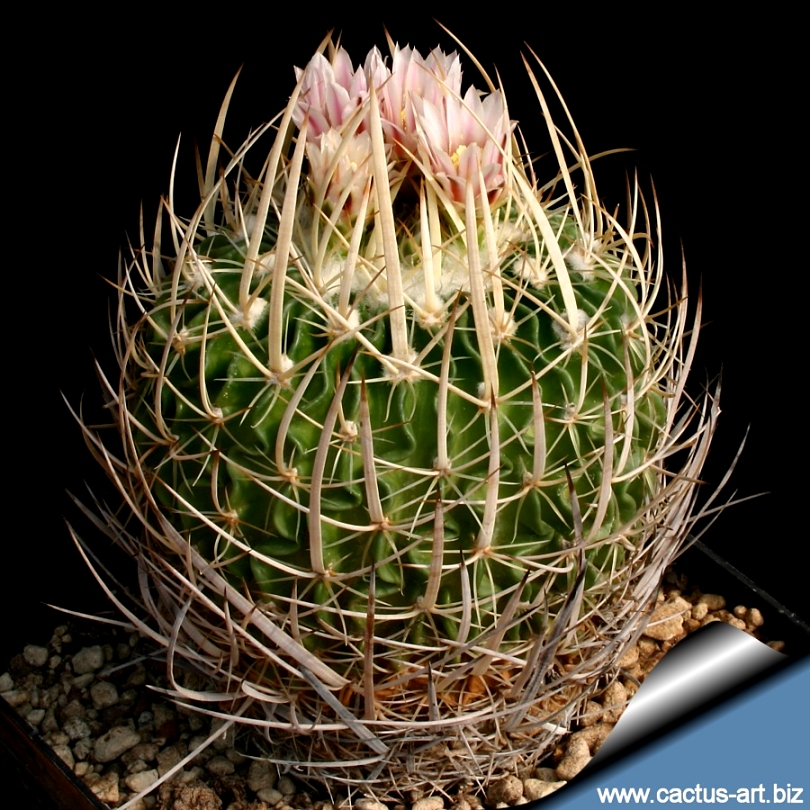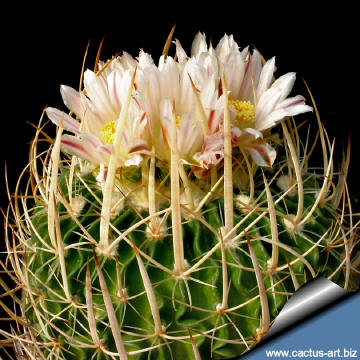|
|
|

This is one of the
species with the prettiest
spination: Spine are flattened, ferocious-looking with one very long
milk-white
central spine directed upwards.
|
 |
Description: E. guerraianus
is a
solitary plant.
Stem: Globular, to 20 cm broad, dark-green with woolly apex.
Ribs: to 35;
Areoles: To 4 cm apart;
Radial spines: Usually 8, white to yellowish, basally brown; Upper
spines 3, to 1.8 cm long, ± flattened; Edge spines: 2 lateral roundish
to 2.8 cm long, 2 (-4) lower thin to 1 cm long;
Central spine: 1,
milky white approximately, 4 cm long;
Flowers: 3 cm long, clear pink to violet with white edge.
Cultivation: Easy to
to care and flower. It needs regular cacti soil with good drainage.
Propagation: Seeds (usually) Exposure: It likes
strong sunshine but is tolerant and do well with light
shade during the hot Summer months, allow to dry between watering.
It should not be watered at all in winter.
Frost Tolerance: does not tolerate intense or
prolonged cold (hardy to -5°C if kept dry) |
|
Photo of
conspecific taxa, varieties, forms and cultivars of
plants belonging to the
echinofossulocactus crispatus
complex
(This
Taxon has lots of
synonyms (like most Echinofossulocactus) whit several controversial
varieties and subspecies):
|
|


Advertising
|
|
|
|
|
Family:
Cactaceae (Cactus
Family) Echinofossulocactus guerraianus
Backeberg, Published in: Das Cacteenlexikon, VEB
Gustav Fischer Verlag, Jena, p. 131 - 1970
Scientific name:
Stenocactus crispatus
(A. P. de Candolle) A. Berger ex A. W. Hill 1933,
(Mexico)
Origin: Mexico (Hidalgo) Identifying the species of an
Echinofossulocactus is as difficult as identifying the genus is easy.
For the most part, they tend to look alike, and there are far more names
than there are species.
|
Synonyms: (of E. crispatus)
- Echinofossulocactus
crispatus (A. P. de Candolle) Lawrence 1841
= Ferocactus crispatus (A. P. de Candolle) N. P. Taylor 1980
= Echinocactus crispatus
A. P. de Candolle 1828
- Echinofossulocactus
dichroacanthus (Martius ex Pfeiffer) Britton et Rose 1922
= Echinocactus dichroacanthus Martius ex Pfeiffer 1837
= Stenocactus dichroacanthus (Martius ex Pfeiffer) A. Berger ex
Backeberg 1935
-
Echinofossulocactus lancifer (A. Dietrich) Britton et Rose
1922
= Echinocactus lancifer A. Dietrich 1839
= Stenocactus lancifer (A. Dietrich) A. Berger ex Backeberg et
F. M. Knuth 1929
-
Echinofossulocactus arrigens
(Link ex A. Dietrich) Britton et Rose 1922
= Echinocactus arrigens Link ex A. Dietrich 1840
= Stenocactus arrigens (Link ex A. Dietrich) A. Berger 1929
-
Echinofossulocactus lamelosus
(A. Dietrich) Britton et Rose 1922
= Echinocactus lamelosus A. Dietrich 1847
= Stenocactus lamelosus (A. Dietrich) A. Berger 1929
- Echinocactus flexispinus
Salm-Dyck 1849
= Echinofossulocactus flexispinus (Salm-Dyck) Bravo 1969
- Echinocactus violaciflorus
Quehl 1912
= Echinofossulocactus violaciflorus (Quehl) Britton et Rose
1922
= Brittonrosea violaciflora
= Echinocactus violaciflorus
= Stenocactus dichroacanthus var. violaciflorus
= Stenocactus violaciflorus,
- Echinofossulocactus confusus
Britton et Rose 1922
= Stenocactus confusus
= Brittonrosea confusa
- Echinofossulocactus guerraianus
Backeberg 1942
- Echinofossulocactus kelleranus (kellerianus)
Krainz 1946
- Echinofossulocactus
multiareolatus Bravo 1960
|
|
|
|

Flowers are usually pale pink or violet
|
|